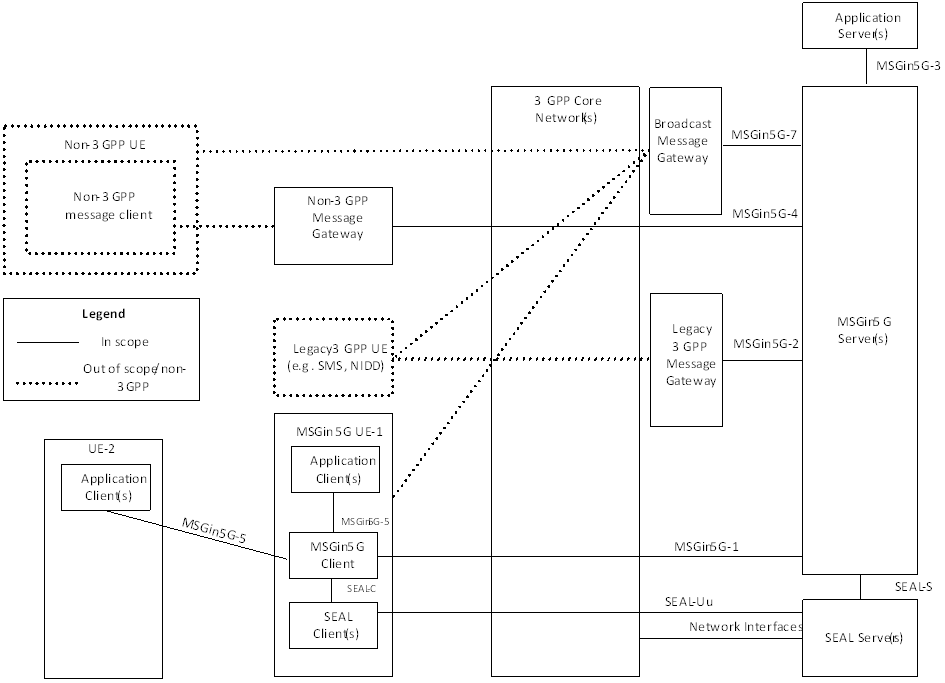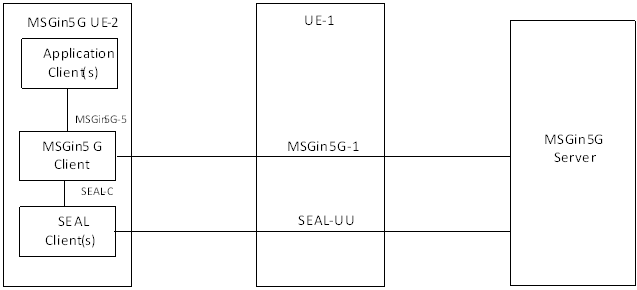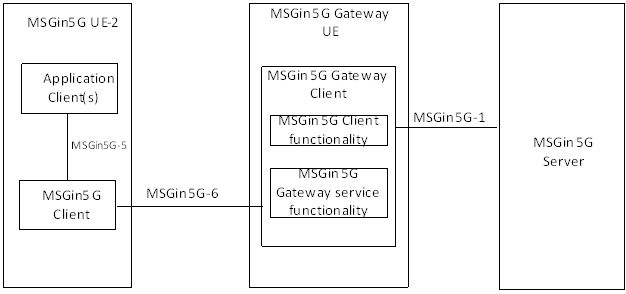Content for TS 23.554 Word version: 19.2.0
5 Application layer architecture p. 13
5.1 General p. 13
The following aspects of MSGin5G Service are described in this clause:
- application architecture;
- functional entities;
- reference points;
- capability exposure for enabling MSGin5G Service; and
- service-based interface representation for MSGin5G Service.
5.2 Application Architecture p. 14
Figure 5.2-1 shows the application architecture of the MSGin5G service. The MSGin5G service shall fulfil the service requirements which are enumerated in TS 22.262 and the architecture requirements enumerated in clause 4.

The Application Client resides on the same UE with the MSGin5G Client as shown in MSGin5G UE-1, or resides on a different UE and interacts with the MSGin5G Client over the MSGin5G-5 reference point as shown in UE-2.
The MSGin5G Client(s) interacts with SEAL Clients over the SEAL-C reference point specified for each SEAL service. The MSGin5G Server(s) interacts with SEAL Servers over the SEAL-S reference point specified for each SEAL service. The interaction between a SEAL Client and the corresponding SEAL Server is supported by SEAL-UU reference point specified for each SEAL service as specified in TS 23.434.
The MSGin5G UE-1 communicates with MSGin5G Server over MSGin5G-1 reference point.
The Legacy 3GPP Message Gateway interacts with MSGin5G Server over MSGin5G-2 reference point on behalf of Legacy 3GPP UE (e.g., SMS, NIDD).
The Non-3GPP Message Gateway interacts with MSGin5G Server over MSGin5G-4 reference point on behalf of Non-3GPP UE.
The Broadcast Message Gateway interacts with MSGin5G Server over MSGin5G-7 reference point.
The architecture shown in Figure 5.2-2 and Figure 5.2-3 illustrate architectural options for providing MSGin5G services for constrained devices. In these figures, the MSGin5G UE-2 is a constrained device which does not connect to the 3GPP network directly for message exchange with MSGin5G Server (e.g. UE-2 is out of 3GPP RAN coverage, with or without authorization to use UE-to-Network relay). If allowed by configuration, the MSGin5G UE-2 can use the options listed below to communicate with the MSGin5G Server:
- the MSGin5G UE-2 uses an UE-1 as relay;
- the MSGin5G UE-2 interacts with an MSGin5G Gateway UE which supports MSGin5G Gateway Client.

Figure 5.2-3 shows the application architecture of MSGin5G UE-2 with MSGin5G Client interacts with an MSGin5G Gateway UE over the MSGin5G-6 reference point. The SEAL Client(s) residing on the UE-2 communicates with the SEAL Client(s) residing on the UE-1 via SEAL-PC5 reference as specified in TS 23.434.

Figure 5.2-3: MSGin5G UE-2 with MSGin5G Client interacts with an MSGin5G Gateway UE
(⇒ copy of original 3GPP image)
(⇒ copy of original 3GPP image)
Figure 5.2-4 illustrates the functional model for interconnection between MSGin5G servers.

To support distributed SEAL server deployment in one PLMN, and delivering MSGin5G messages between different PLMNs, the MSGin5G Server interacts with another MSGin5G Server over MSGin5G-8 reference point.